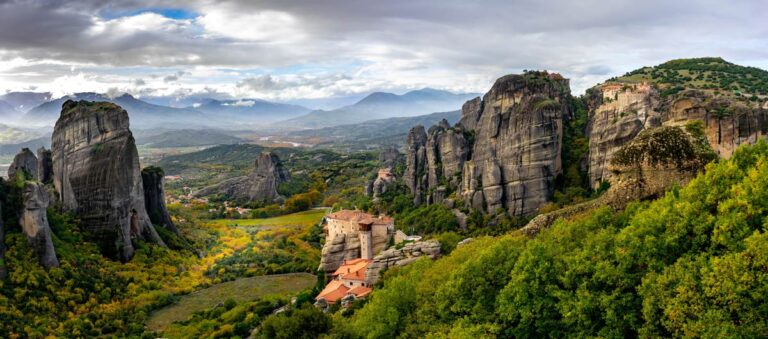
We are reader-supported and may earn a commission on purchases made through links in this article.
Nestled in the mountains of central Greece is a land that time forgot. Giant fingers of brown sandstone rise up out of the Kalambaka Valley like the hands of God reaching toward heaven.
Perched miraculously on the tips of these fingers are the Meteora monasteries and one convent, all of which are active and thriving.
Columns of the Sky
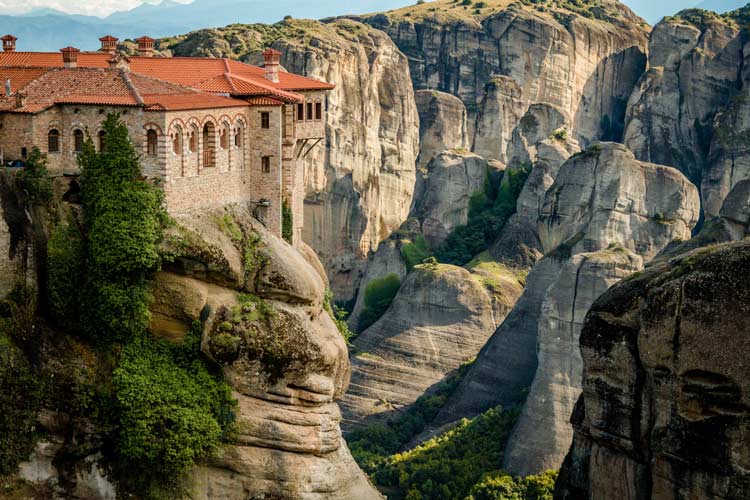
The area is called Meteora, and it literally means “columns of the sky.”
In the 11th century, holy monks began to occupy caves high up in the almost inaccessible peaks. These were natural refuges from the distractions of civilization and a quiet place in which to lead a life of contemplation.
These hermit caves can still be seen from the highway. Some are hundreds of feet up a sheer cliff. Once inside, the occupant was there to stay. None are currently in use but are popular stopovers for rock climbers scaling the vertical heights.
24 of these monasteries were built in Meteora during the great revival of the eremitic ideal in the 15th century.
Read More: Top 10 Things to Do in Greece
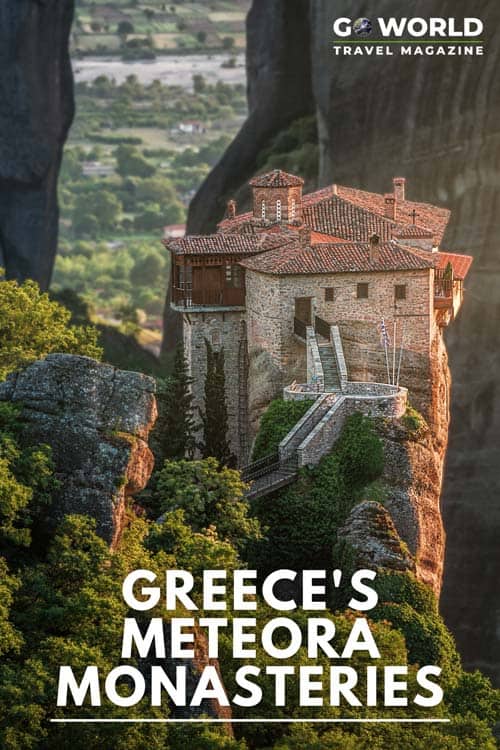
The Oldest Meteora Monastery
The oldest monastery was begun around 1382 during the Turkish occupation when the local monks kept climbing higher to avoid the looting and banditry infecting the area.
Once atop these almost inaccessible peaks, they lowered rope ladders to friends on the ground that sent up building materials and food. A system of levered pulleys with large baskets followed, and that is how they bring up their supplies to this day.
Now, there are roads connecting all the buildings, but the inhabitants mostly use the old baskets and even have a hand-pulled cable car system for crossing some of the deeper chasms.
Creaking cables cause all eyes to look up at a basket full of monks inching along a tiny cable a thousand feet (305 m) above the valley floor. The natural rock buildings blend so even with the scenery, they are hard to spot at first. Only the red tile roofs give them away.
Centuries of weather have caused natural streaking of the rock acts as a natural camouflage. A plaque over one monastery door telling the history of the valley says the streaks are monk’s tears, crying for the sins of the outside world.
Upon completion, the monastery Megalo Meteoro, or Metamorphosis, claimed the former Serbian Emperor, Symeon Uros, as a monk.
Read More: How to Pack Light for Any Length Trip Abroad
A Visit to the Main Chapel
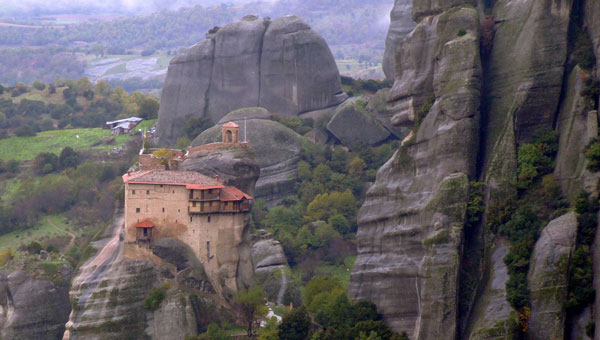
He gave the bulk of his wealth to his new home and had the interior frescoed with gruesome scenes of Romans persecuting Christians. A visit to the main chapel is like a tour through one of Hieronymus Bosch Renaissance painting where blood and torn flesh is the order of the day.
Next in time came the Agia Triada, or Holy Trinity monastery, built during the 15th century. It is the most photogenic of them all and even starred in the James Bond Movie, “For Your Eyes Only.” Today, Agia Triada is the poster ad for all of Meteora.
Even with the modern parking lot at its base, a visitor must climb 140 steps cut into the rock wall. It sits on the steepest and most isolated of all these rock fingers.
Two monks who named it for an esthetic hermit that had originally occupied the mountaintop founded the Varlaam Monastery in 1517. It houses a valuable collection of Byzantine relics, from carved crosses and icons to intricately embroidered altar vestments.
A famous muralist named Frangos Katelanos frescoed its interior. Building upon the old site of a former church, two brothers founded the Roussanou Monastery in 1545. It is the most inaccessible, having to cross a wooden bridge between two fingers peaks to reach its draw gate, and it is known for its icon collection.
Visiting the Meteora Monasteries
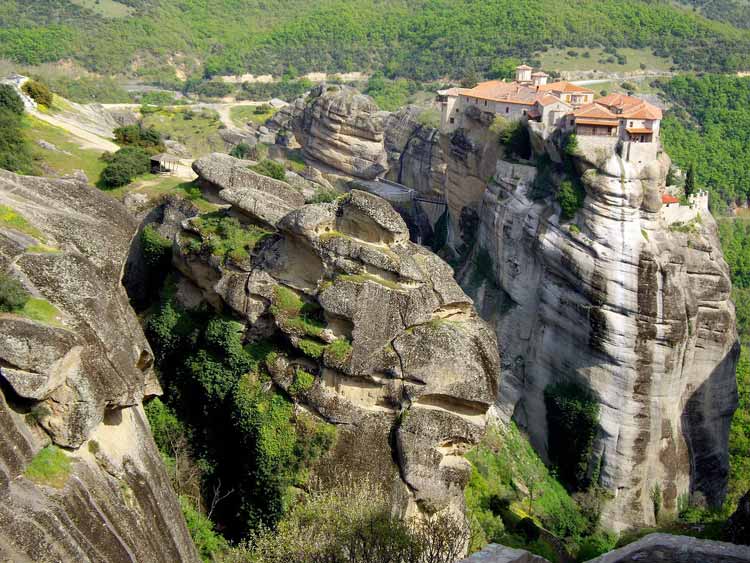
Agios Nikolaos Anapafsas was named for a patron responsible for funding its construction in the 16th century. It is the smallest of the Meteora monasteries and sits on a stub of sandstone alongside its much taller brothers, looking very much like a thumb to the finger towering over it.
The valley’s single convent, Agios Stefanos, or Saint Stephan, is fairly modern by local standards, having been built in 1798 after the original church was destroyed? possibly by an earthquake.
The occupying nuns are courteous and friendly, but no visitor gets past them with bare shoulders or knees. Novices holding piles of plain blue aprons and capes meet tourist buses at the gate.
Anyone not meeting the exacting dress standards must don the local sackcloth or be turned away. Once inside, novitiates line the walkway with fingers to their lips, reminding people that this is a place of worship.
The nunnery houses a large skull collection of former members. It is a powerful reminder of the impermanence of this life. Inside the walls of these Byzantine fortresses, life goes on as it has for more than 900 years.
Wine is still made in giant oak vats where the monks climb in with bare feet to crush the grapes. Most of the carpentry and masonry tools are handmade in the same style as their Greek ancestors.
Meeting with the Monk
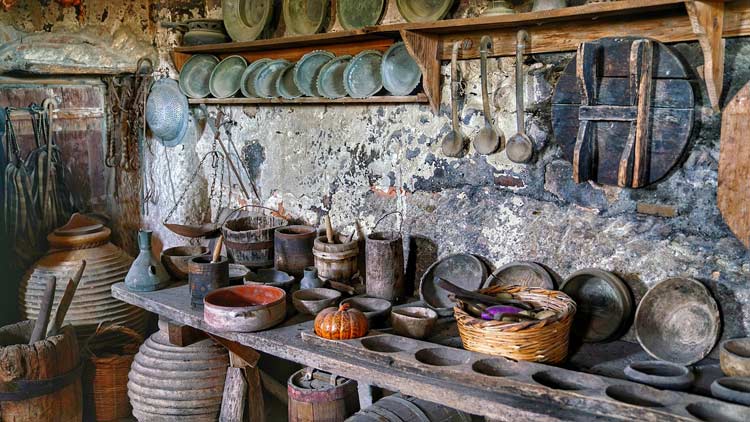
A monk in a leather apron works hand-pumped bellows on a furnace where terracotta bowls are fired. Bearded black-robed monks wander the cobbled streets with bowed heads buried in their vespers.
If approached with a camera, they will turn away or issue a fierce look that leaves no doubt about taking their photo. In a tiny studio tucked away by itself, I came upon a monk painting traditional icons. He did not acknowledge me as I entered, but neither did he turn me away when he saw my camera.
Perhaps he allowed himself this one tiny act of vanity, being proud of his work. He used hand-ground pigments bonded with egg yolk to make tempera paint common in the Middle Ages but almost unheard of today.
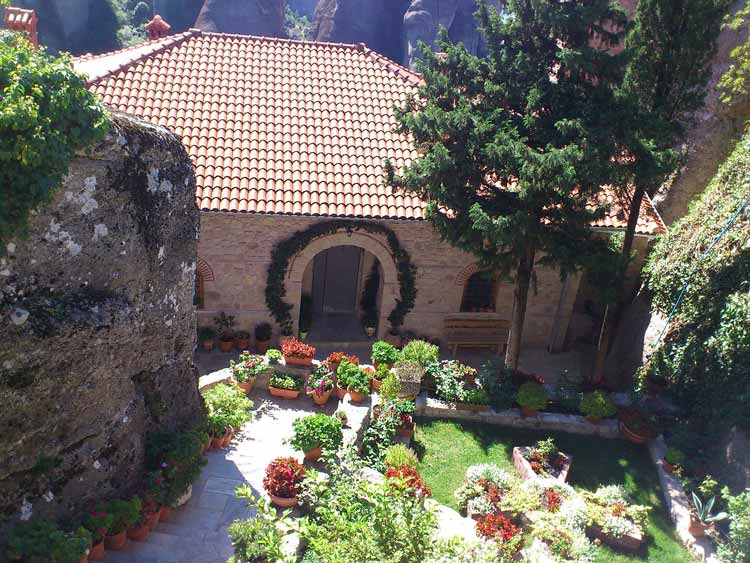
He outlined his subjects in pencil, then applied real gold leaf backgrounds. The gold leaf was applied by rubbing it over his forehead using natural oils in his skin as an adhesive. Icons are a time-honored tradition in Greece, and this man has continued a line that has been unbroken for centuries.
All who dwell within these walls have forsaken the modern world. Visitors are welcome, but there is little or no interaction between tourists and the inhabitants. The one concession they make to the modern world is their gift shops. Each building has one, selling reproductions of icons, statues and books about the history of the valley and its famous residents.
The monks and nuns who man the cash registers are friendly and courteous but self-contained. If you ask a personal question or anything not covered by a guidebook, they will stonewall you with a polite smile. They are among us, but not of us.
Today, you can park your car and climb a walkway to all these places, but once you pass their gates, you step back centuries to the land in the clouds.
If You Go:
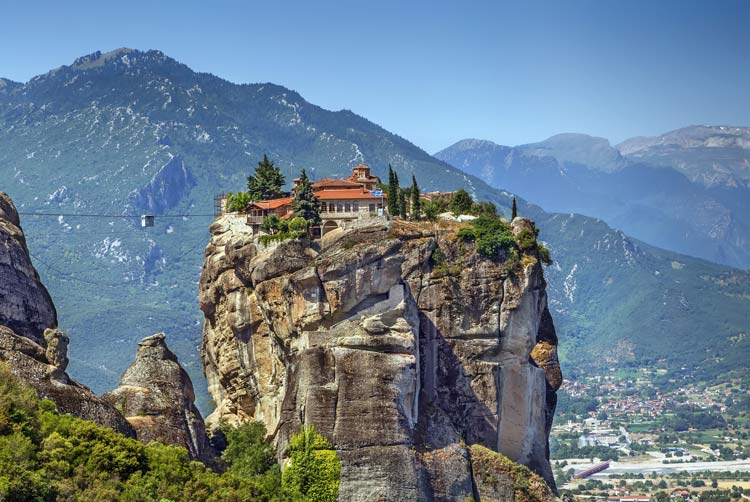
Check out our Greece Travel Guide for more information.
How to Get There
Take a four-hour ride by bus or catch a train from Athens’ Larissis Station to the town of Volos in central Greece. Then take the narrow gauge railway to Kalambaka. Once in town, any taxi driver will give you a tour. The group of Meteora monasteries is about a mile (1.6 km) north of Kalambaka.
The Hilltop Monastery
Hire George Kokkotos. George is a local native who drove cabs in New York for several years before returning home to run his one man tour company and has become rather famous.
He will pick you up in his Mercedes sedan and make the three-hour drive to Delphi for a tour of the ruins. Then it’s on to Meteora where George will arrange for you to stay in one of a number of private residences on local farms. Each trip is custom, depending on what you want to see and do. Reach George through his email at [email protected].
Where to Stay
In Kalambaka try the Divani Meteora Hotel. This is a four-star luxury hotel with 165 rooms, pool and on-site restaurant and bar in downtown Kalambaka. This town is so small; you can see all of it from the central square.
Antoniades Hotel is well suited for budget travelers. The two-star hotel popular with backpackers and rock climbers has 59 rooms with a restaurant.
Read More:
Author: James Michael Dorsey
- Why the Kimberley Should Be Your Next Australian Adventure - July 5, 2025
- How We Finally Afforded Our Dream Trip to the Swiss Alps (And You Can Too) - July 5, 2025
- Escape Manhattan for Governors Island - July 5, 2025

